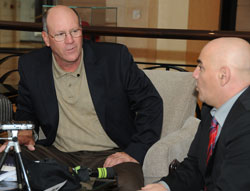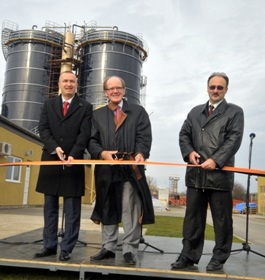A blizzard was brewing outside but the brand new Ag Leader Academy was just getting warmed up yesterday in Ames, Iowa.
 ZimmComm’s Precision Pays website reporter Kurt Lawton was there for the kick off of the academy, along with more than 200 dealers who attended to learn about all the company’s new products and the steering technology and services gained from the recently announced partnership with AutoFarm.
ZimmComm’s Precision Pays website reporter Kurt Lawton was there for the kick off of the academy, along with more than 200 dealers who attended to learn about all the company’s new products and the steering technology and services gained from the recently announced partnership with AutoFarm.
There was a lot of buzz about teaming up two new products in particular, which highlights the strengths of the new partnership between Ag Leader and AutoFarm. The ability to pair the new ‘flagship’ products—Ag Leader’s INTEGRA monitor with the high-accuracy automatic steering ParaDyme product from AutoFarm—will offer the most advanced and innovative precision ag system ever, say the companies.
The INTEGRA full-featured, year-around display, comprised of a 12-inch HD touchscreen, features a new hardware platform that can handle mapping, planter and application control, yield monitoring, real-time data logging and more—controlling virtually every operation from the cab.
And to make this a fully integrated system, a patented dual-antenna roof module called the ParaDyme, delivers a unique steering system that can handle any correction (from WAAS to RTK), plus it offers factory-activated and integrated wireless and cellular communications for remote diagnostics. It not only can provide sub-inch accuracy with RTK or the CORS Network, but it can track pitch, roll, yaw, vehicle position and heading.
Read more about it here on Precision Pays.

 The USDA Ag Specialist on the ground in Jordan is Mohamed N. Khraishy. He took time to meet with our Corn Mission team after we arrived this afternoon. He says that he acts mainly as a facilitator on our behalf or as he puts it, “See me as the grease between the wheels.”
The USDA Ag Specialist on the ground in Jordan is Mohamed N. Khraishy. He took time to meet with our Corn Mission team after we arrived this afternoon. He says that he acts mainly as a facilitator on our behalf or as he puts it, “See me as the grease between the wheels.”
 The Regional Director for the U.S. Grains Council coordinating our Corn Mission visit to Jordan is Joe O’Brien. Joe covers the Middle East and part of India.
The Regional Director for the U.S. Grains Council coordinating our Corn Mission visit to Jordan is Joe O’Brien. Joe covers the Middle East and part of India.  So if you have not made plans to attend
So if you have not made plans to attend  Fellow Show Me State resident and corn grower from the southeast part of Missouri, Jim Stuever, took a few moments to provide his thoughts on how the
Fellow Show Me State resident and corn grower from the southeast part of Missouri, Jim Stuever, took a few moments to provide his thoughts on how the 
 The nation’s dairy producers are mourning the loss of an industry leader,
The nation’s dairy producers are mourning the loss of an industry leader, 